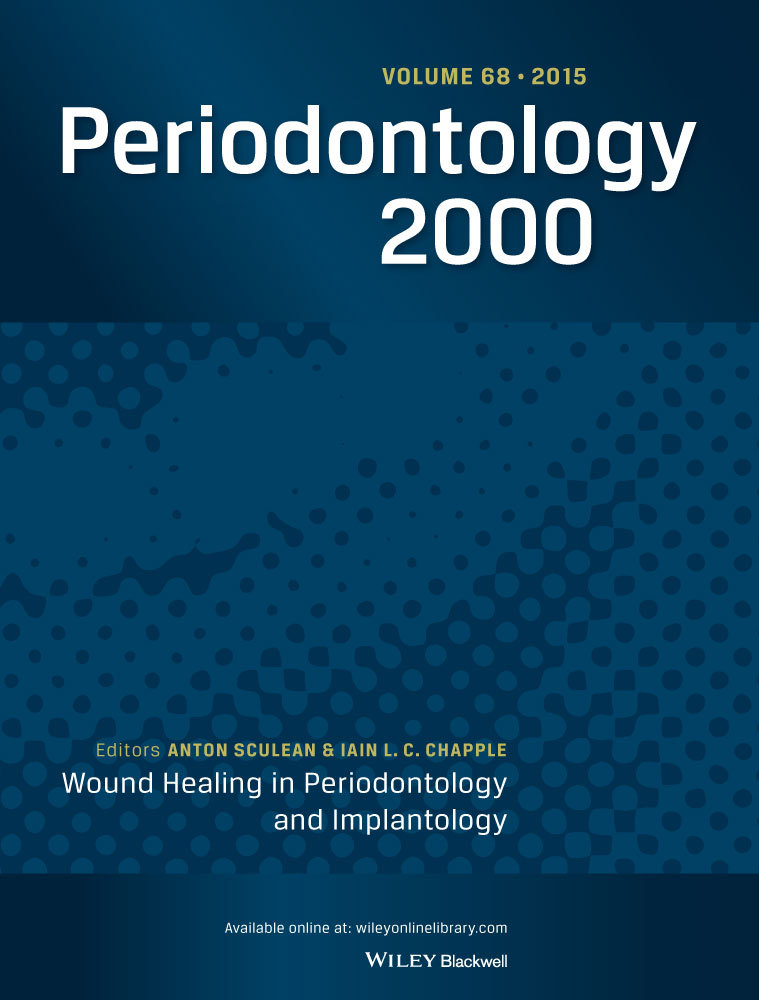Soft-tissue volume augmentation during early, delayed, and late dental implant therapy: A systematic review and meta-analysis on professionally determined esthetics and self-reported patient satisfaction on esthetics.
IF 15.7
1区 医学
Q1 DENTISTRY, ORAL SURGERY & MEDICINE
引用次数: 0
Abstract
The objective of the study was to assess the effect of soft-tissue volume augmentation during early, delayed, and late dental implant therapy in terms of professionally determined esthetics and self-reported patient satisfaction on esthetics. For this, a comprehensive electronic literature search was performed to identify randomized clinical trials (RCTs) and controlled clinical trials (CCTs) reporting professionally determined esthetic outcomes and self-reported patient satisfaction on esthetics (primary outcomes) during early, delayed, and late dental implant placement comparing soft-tissue volume augmentation to the absence of soft-tissue grafting (control) (PICO 1) or comparing various soft-tissue augmentation techniques, procedures, and materials (PICO 2). Secondary outcomes were mucosal thickness (MT), intra- and postoperative complications, marginal soft-tissue-level changes, keratinized tissue width, radiographic marginal bone levels, and clinical parameters for the diagnosis of peri-implant tissue health. The standard mean differences (SMD)/weighted mean differences (WMD) were estimated for the Pink Esthetic Score (PES), self-reported patient satisfaction assessed by Visual Analog Scale (VAS) and MT gain for PICO 1 and PICO 2 by employing a random effect model. Five RCTs were included for PICO 1, whereas 7 RCTs and 1 CCT addressed PICO 2. PICO 1: The SMD for the PES between autogenous soft-tissue grafting (SCTG) and the absence of grafting (control group) was 0.47; 95% CI [-0.15, 1.09; p = 0.14] based on 5 RCTs. The SMD for the VAS values for patient-reported satisfaction on esthetics in the SCTG and control group was 0.46; 95% CI [-0.12, 1.03; p = 0.12] (2 RCTs). The WMD for gain of MT amounted to 1.06 mm; 95% CI [0.81, 1.31; p = 0.00] in favor of the SCTG group (3 RCTs). PICO 2: The SMD for the PES comparing collagen-based matrices (CM group) to the SCTG group was -0.32; 95% CI: (-0.57, -0.07; p = 0.01), in favor of the SCTG group (5 RCTs and 1 CCT). The SMD for the VAS for patient-reported satisfaction on soft-tissue esthetics was 0.24; 95% CI: (-0.31, 0.78; p = 0.40) (2 RCTs comparing CM vs. SCTG). The WMD for gain of MT was -0.27 mm; 95% CI: (-0.36, -0.17; p = 0.00), significantly favoring the SCTG group (4 RCTs). Professionally and patient-assessed outcomes showed no substantial differences between autogenous soft-tissue grafting and the absence of grafting for early, delayed, and late implant placement. However, autogenous soft-tissue grafts led to significantly improved esthetic outcomes as assessed by professionals compared to soft-tissue substitutes. Patient-assessed outcomes, nevertheless, were similar regardless of the grafting material (i.e., SCTG or soft-tissue substitute). Therefore, autogenous soft-tissue grafting, though, resulted in a considerably higher gain in mucosal thickness compared to both the absence of soft-tissue grafting and the use of soft-tissue substitutes. Complications and adverse events were rarely reported by the included studies, thus suggesting that many trials underreport harms (e.g., complications).早期、延迟和晚期植牙治疗中的软组织体积增大:一项关于专业美学和患者自我报告美学满意度的系统回顾和荟萃分析。
本研究的目的是评估软组织体积增大在早期、延迟和晚期牙科种植治疗中对专业确定的美学和患者自我报告的美学满意度的影响。为此,进行了全面的电子文献检索,以确定随机临床试验(rct)和对照临床试验(cct)报告专业确定的美学结果和患者自我报告的美学满意度(主要结果),在早期,延迟和晚期牙科种植体放置,比较软组织体积增加与没有软组织移植(对照)(PICO 1)或比较各种软组织增加技术。次要结果是粘膜厚度(MT)、术中和术后并发症、边缘软组织水平变化、角化组织宽度、放射学边缘骨水平和用于诊断种植体周围组织健康的临床参数。采用随机效应模型估计粉红美学评分(PES)的标准平均差异(SMD)/加权平均差异(WMD),采用视觉模拟量表(VAS)评估自我报告的患者满意度,PICO 1和PICO 2的MT增益。5个随机对照试验被纳入PICO 1,而7个随机对照试验和1个CCT被纳入PICO 2。PICO 1:自体软组织移植(SCTG)与未移植(对照组)PES的SMD为0.47;95% ci [-0.15, 1.09;p = 0.14],基于5项rct。SCTG组和对照组审美满意度VAS值的SMD为0.46;95% ci [-0.12, 1.03;p = 0.12](2个rct)。MT的增益WMD为1.06 mm;95% ci [0.81, 1.31;p = 0.00]有利于SCTG组(3个rct)。PICO 2:胶原基基质(CM组)与SCTG组PES的SMD为-0.32;95% ci: (-0.57, -0.07;p = 0.01),有利于SCTG组(5个rct和1个CCT)。VAS对患者报告的软组织美学满意度的SMD为0.24;95% ci: (-0.31, 0.78;p = 0.40)(2个rct比较CM和SCTG)。MT的增益WMD为-0.27 mm;95% ci: (-0.36, -0.17;p = 0.00),明显有利于SCTG组(4个rct)。专业人员和患者评估的结果显示,自体软组织移植与早期、延迟和晚期植入物不移植之间没有实质性差异。然而,据专业人士评估,自体软组织移植物与软组织替代品相比,显著改善了审美结果。然而,无论移植材料(即SCTG或软组织替代品)如何,患者评估的结果都是相似的。因此,自体软组织移植与不进行软组织移植和使用软组织替代物相比,粘膜厚度的增加要高得多。纳入的研究很少报告并发症和不良事件,因此表明许多试验低估了危害(例如并发症)。
本文章由计算机程序翻译,如有差异,请以英文原文为准。
求助全文
约1分钟内获得全文
求助全文
来源期刊

Periodontology 2000
医学-牙科与口腔外科
CiteScore
34.10
自引率
2.20%
发文量
62
审稿时长
>12 weeks
期刊介绍:
Periodontology 2000 is a series of monographs designed for periodontists and general practitioners interested in periodontics. The editorial board selects significant topics and distinguished scientists and clinicians for each monograph. Serving as a valuable supplement to existing periodontal journals, three monographs are published annually, contributing specialized insights to the field.
 求助内容:
求助内容: 应助结果提醒方式:
应助结果提醒方式:


